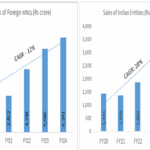“- Nutritional disorders prevalent in urban areas, 38 % women suffer from anaemia
– Uric Acid, lipid profile tests also come up with worrisome statistics
– Preventive health check-up, need of the hour”
New Delhi, April 6, 2018:
Increasing urbanisation coupled with rapidly changing lifestyles is leading to deficiencies across several important health parameters amongst Indians. While ailments related to important organs such as kidney and liver are on the rise, urban citizens of the country also fared poorly in other important counts including important vitamin deficiencies. An analysis of the data collected by SRL Diagnostics – India’s largest and most trusted diagnostics chain – showed a worrisome trend. The data was collected by SRL Diagnostics over a period of three years during 2015 – 2017 from across its centers in 29 states and four union territories.
“We have noticed an alarming level of Vitamin D inadequacy in the country. And this finding is in sync with the findings of other medical research studies conducted in the country earlier. Of the total samples analysed, 79.12 percent had either Vitamin D deficiency or insufficiency. While women were more commonly Vitamin D insufficient, men showed more cases of Vitamin D deficiency. Similarly, an analysis of Kidney Function Test results showed that 10.40 percent had abnormal values of Blood Urea Nitrogen (BUN), Serum Creatinine or both. The results also showed that there was a rapid rise in abnormal KFT values in the ages above 60 years,” said, Dr B.R Das, Advisor and Mentor – R&D, SRL Diagnostics
The analysis of Lipid Profile results meanwhile indicated that 34 percent of the population had abnormal values for one or more of the four parameters – HDL, Triglycerides, LDL and Total Cholesterol. While men have more deranged LDL, HDL and Triglyceride levels than women, on an average the total Cholesterol level was found to be higher in women.
Another worrisome trend came from the analysis of glucose tests, which are conducted to establish the inability to process sugars correctly – precursor to diabetes. In pan India analysis on samples received mainly from urban areas, 19.22% of individuals were observed to be either pre-diabetic or diabetic, with men accounting for 20.80 percent and women, 17.36 percent.
“When we compared abnormal values across age groups, we observed that the age groups of 46-60 and 61-85 years showed the highest prevalence of (26.71% and 27.01% respectively) of presumed diabetics or pre-diabetics across four zones of India,” added Dr. Das.
Similarly, analysis of various other important tests like Vitamin B12, Thyroid Stimulating Hormone, Haemoglobin and Uric Acid too threw up abnormal results in individuals who had come for preventive health check tests.
For haemoglobin particularly, 38 percent of women were diagnosed with anaemia (16 % in men). Women from the eastern part (~50%) of India showed higher number of anaemia cases as compared with the other three zones. Of all the individuals who enrolled for Preventive Health Check tests, 13.46% showed high levels of uric acid.
“These results highlight the importance of preventive health check-ups and the growing awareness among people for availing diagnostic services. With recent development in medical science and technology, many diseases can be prevented or cured to a large extent with right and early diagnosis. On the important occasion of World Health Day, we reaffirm our commitment for creating awareness in the society for a healthy India,” he added.
Speaking on the occasion of World Health Day, Mr. Arindam Haldar, CEO, SRL Diagnostics said, “This year, World Health Day’s theme of “Universal health coverage: everyone, everywhere” – essentially focuses on the fact that every individual must have access to affordable and quality healthcare, without prejudice of any kind. This is in line with SRL’s vision of providing quality diagnostics services to the masses at reasonable cost. For some time now, SRL has been working towards shifting the mindset of people from illness based diagnostics to wellness based preventive healthcare approach. As leaders and decision makers we need to understand that the absence of a disease is always going to be of higher value to the society than achieving excellence in treating it. With the Government of India picking up pace with the Preventive Healthcare, it is now the turn of the private sector to play its role in creating awareness about Preventive care, by leveraging our reach and resources.”
“We must maintain our focus on leveraging technology, both biomedical and communication to the best of our capabilities thereby accelerating our progress towards universal health coverage (UHC). A multi-stakeholder approach with policymakers, private players, medical professionals, academicians and above all people from all strata of the society must be adopted to mobilise resources and accomplish the goal of healthcare for all,” he added
Some important findings of the report:
Vitamin D Test Analysis:
- Of the total samples analyzed for Vitamin D, 79.12% had either Vitamin D deficiency or insufficiency.
- Men showed a more deranged Vitamin D level (81.08%) compared to women (77.08%). Women were more commonly vitamin D insufficient while men were vitamin D deficient.
- South zone (85.04%) had the most deranged values of vitamin D while North (77.42%) zone showed the least deranged values.
- There is a decreasing trend in the subnormal levels of Vitamin D with increasing age. The derangement is most common in younger population of 16 to 35 years while it’s the least deranged in older population above 60 years.
Liver Enzymes Analysis:
- Among the liver enzymes, SGPT levels were the most deranged followed by SGOT and ALP in the analysed population.
- Men had higher SGPT and SGOT levels compared to women while women reflected higher ALP levels compared to men.
- East zone had the most deranged levels of liver enzymes compared to the other three zones of India.
- Derangement in SGPT and SGOT values showed a continuous decrease post the age of 45. On the contrary, ALP levels were found to increase consistently with age.
Kidney Function Test Analysis:
- Of the total individuals enrolled for preventive health check-up, 10.40% had abnormal values of blood urea nitrogen (BUN) and serum creatinine (SCr) or both.
- More number of women had deranged KFT values than men.
- Similar to liver chemistries, East zone had the most deranged KFT values, while the North zone reflected the least derangement in KFT levels.
- There was a rapid rise in abnormal KFT values in the age group of 61 to 85.
Lipid Profile Analysis:
- Approximately 34% of the population who enrolled for preventive health check-up showed abnormal levels in one of the four parameters.
- Men revealed more deranged LDL, HDL and Triglyceride levels than women; while Total Cholesterol level was found to be higher in women than men.
- Total and LDL Cholesterol levels were found to be most deranged in West India and the least deranged in East India. Derangement in HDL values was the highest in North zone and the least in West zone. Triglycerides levels were more or less non-variable across all zones.
- Deranged levels of Total Cholesterol, LDL and Triglycerides are negligible in the age group 16 to 30 years. They are seen to be increasing in age between 31 to 60 years, however population above 60 years have showed a comparative drop in the deranged levels of Total Cholesterol, LDL and Triglycerides, possibly because of medication. Abnormal HDL, the most commonly deranged lipid test across India, however remains more or less similar in all age groups.
Glucose Test Analysis:
- In pan India analysis, 19.22% of individuals were observed to be diabetic or prediabetic as per the consideration of two out of the three test values to be higher than the normal range (FBS; PPBS,HbA1c).
- Men (20.82%) were observed to have higher % of abnormal sugar levels than women (17.36%).
- Cutting across the zones of India, individuals from the western part (20.47%) threw up most number of diabetic/prediabetic candidates.
- When we compared abnormal values across age groups, we observed that the age groups of 46-60 and 61-85 years showed the highest prevalence of (26.71% and 27.01% respectively) of glucose metabolism defects across four zones of India.
Vitamin B12 Test Analysis:
- Among the individuals scanned for preventive health checks, approximately 30% of the samples analyzed showed abnormal levels of vitamin B12.
- Prevalence of abnormal levels of vitamin B12 was more commonly found in men (33.28%) than women (27.85%).
- Abnormal levels of vitamin B12 were more prevalent in the western part of India than the other three zones.
- ü Age-group of 31-45 years showed majority of abnormal levels of vitamin B12.
Thyroid Function Test Analysis:
- Among the preventive health check samples, the thyroid levels were observed to be above the normal range in approximately 45000 (18.17%) individuals across pan India.
- Abnormal thyroid function levels were more common in women (21.45%) than in men (15.06%).
- Individuals from the eastern part of India showed most number of abnormal thyroid cases than the other three zones.
- Majority of abnormal thyroid level individuals were more commonly observed in the 61-85 age group (21.32%)
HBsAg Test Analysis:
- In pan India analysis, less than 1% of individuals were observed with hepatitis B infections.
- Men and women across the country are equally vulnerable to contract hepatitis B infection.
Haemoglobin Test Analysis:
- Based on the haemoglobin concentration in this pan India analysis, women (around 38%) were more frequently observed with anaemia cases than men (16%).
- Women from the eastern part (~50%) of India showed higher number of anaemia cases as compared with the other three zones.
- Women aged 61 years onwards were more likely to suffer from anaemia.
Uric Acid Test Analysis:
- Of all the individuals who enrolled for Preventive Health Check Up, 13.46% showed high levels of uric acid.
- Men had a higher level of derangement in the Uric Acid level that women. The probable cause of decreased level of Uric Acid can be attributed to the protective role of estrogen in women.
- East zone showed the most deranged uric acid level compared to other zones, while North India reflected the least derangement in uric acid levels.
- An increasing trend in the derangement in Uric acid levels was observed with increasing age. Age group 61 to 85 had the most abnormal levels compared to age group 16 to 30.







